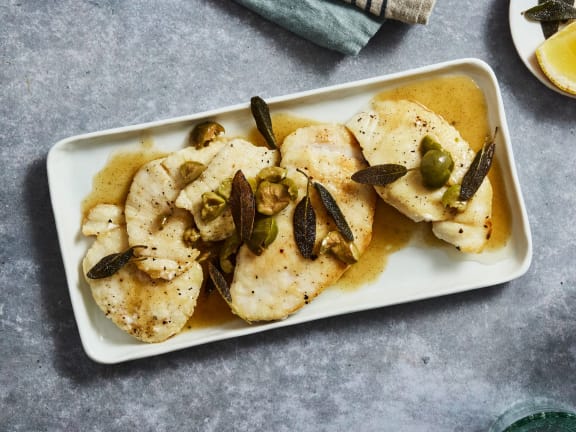This recipe for pan-fried Pacific halibut cheeks is served with a decadent brown butter sauce, punctuated with earthy, fried sage leaves and mild green Castelvetrano olives. The brown butter sauce is a rich topping for lean, wild-caught white fish — a sauce that you can make over and over again to finish any recipe.
Pan-frying is a great way to cook Pacific halibut cheeks, as this method allows you to control the doneness of each piece since there’s so much variation in size. It’s easy to remove smaller pieces from the pan as soon as they’re done cooking, while leaving the bigger pieces to finish.
Chef’s note: Emulsified sauces can break — the water-based element of the sauce can separate from the fat, the same way that salad dressings eventually separate into oil and vinegar. A “broken” sauce tastes just as good as one that’s emulsified, but it won’t have that smooth, spoonable consistency.
You can enjoy it as is, or re-emulsify it like this:
-
In a small saucepan, bring ¼ cup water to a boil, then remove from heat.
-
Slowly drizzle broken sauce into the water, making sure to whisk continuously. Put the saucepan back on heat source from time to time to keep it just below a simmer. Continue to whisk until it emulsifies into a smooth sauce again.
About Chef George Pramatarov:
George Pramatarov is a chef based in Minneapolis, Minnesota. Over the past decade, he has worked at several award-winning restaurants including St. Genevieve, Hai Hai, Grand Cafe, and Petite Leon—recently included in New York Times's 50 Favorite Restaurants of 2022. Born and raised in Bulgaria, George moved to the United States at age 14 and is equally influenced by Bulgarian, French, and American cuisine. Through cooking food and creating recipes, he is continually revisiting the feeling of home. When not cooking, George unwinds with his partner, Sara, and their crazy Beagle at the family lakeside cabin in Wisconsin.






